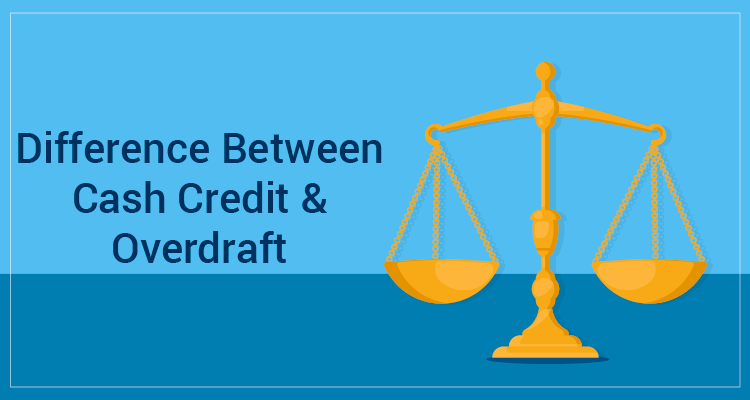In the world of finance, understanding the various tools and options available to manage your business's finances is crucial. Two common financial instruments often used by businesses are Cash Credit and Overdraft. Both these financial tools have their own merits and demerits, and understanding the differences between them can help you make informed decisions about your business's financial needs.

Understanding Cash Credit
What is Cash Credit?
Cash Credit, often referred to as CC, is a type of loan provided by banks to businesses to meet their working capital requirements. It allows businesses to withdraw money up to a certain credit limit. The interest is charged only on the amount withdrawn, making it a flexible financial tool.
How Does Cash Credit Work?
Cash Credit functions like a revolving line of credit. Businesses can withdraw funds as and when required, up to the sanctioned limit. Interest is calculated on the daily outstanding balance. Repayments can be made at any time, which makes it a flexible option for businesses with fluctuating cash flows.
Advantages of Cash Credit
- Flexibility in fund utilization.
- Interest is charged only on the amount withdrawn.
- Continuous access to funds.
- Suitable for businesses with seasonal cash flow variations.
Disadvantages of Cash Credit
- Requires good creditworthiness.
- May involve collateral or guarantees.
- Interest rates can be relatively high.
Understanding Overdraft
What is Overdraft?
Overdraft, often known as OD, is a financial arrangement that allows businesses to withdraw more money than they have in their bank account. It is essentially a short-term loan that helps businesses cover unexpected expenses or temporary cash shortages.
How Does Overdraft Work?
Overdraft allows businesses to withdraw funds even when their account balance is zero. The overdrawn amount incurs interest, and it is typically a short-term facility. Overdrafts are often linked to the business's current account.
Advantages of Overdraft
- Quick access to funds in emergencies.
- No need to pledge assets as collateral.
- Only pay interest on the overdrawn amount.
Disadvantages of Overdraft
- Higher interest rates compared to other loans.
- May have overdraft fees.
- Not suitable for long-term financing needs.
Cash Credit vs. Overdraft
Key Differences
The primary difference between Cash Credit and Overdraft lies in their purpose. Cash Credit is designed for meeting working capital requirements and is usually suitable for businesses with varying cash flows. On the other hand, Overdraft is meant for covering temporary cash shortages or emergencies.
When to Use Cash Credit
Cash Credit is ideal for businesses that require continuous access to funds for their daily operations. It is suitable for managing working capital, purchasing inventory, and covering operational expenses.
When to Use Overdraft
Overdraft is best utilized for short-term financial needs. Businesses can use it to bridge gaps in cash flow, cover unexpected expenses, or manage seasonal fluctuations.
Pros and Cons of Cash Credit and Overdraft
Both Cash Credit and Overdraft have their advantages and disadvantages. It's essential to consider your business's financial situation and requirements when choosing between the two.
- Pros of Cash Credit:
- Flexibility in fund utilization.
- Continuous access to funds.
- Suitable for businesses with seasonal cash flow variations.
- Cons of Cash Credit:
- Requires good creditworthiness.
- May involve collateral or guarantees.
- Interest rates can be relatively high.
- Pros of Overdraft:
- Quick access to funds in emergencies.
- No need to pledge assets as collateral.
- Only pay interest on the overdrawn amount.
- Cons of Overdraft:
- Higher interest rates compared to other loans.
- May have overdraft fees.
- Not suitable for long-term financing needs.
Application Process for Cash Credit and Overdraft
The application process for Cash Credit and Overdraft varies from one bank to another. Generally, it involves submitting financial documents, business plans, and demonstrating the need for the facility. Lenders assess your creditworthiness before approving the request.
Case Studies
Let's take a look at a few hypothetical case studies to understand how businesses can benefit from Cash Credit and Overdraft in different scenarios.
How to Choose Between Cash Credit and Overdraft
Choosing between Cash Credit and Overdraft depends on your business's specific financial needs. Consider factors such as the nature of your business, cash flow patterns, and the urgency of fund requirements. It's often wise to consult with a financial advisor or your bank for guidance.
Conclusion
In conclusion, Cash Credit and Overdraft are two financial tools that serve different purposes. Understanding the differences between them can help businesses make informed decisions about their finances. By evaluating your business's unique needs and financial situation, you can choose the right option to meet your requirements.
FAQs
1. What is the primary difference between Cash Credit and Overdraft? The key difference lies in their purpose. Cash Credit is for working capital needs, while Overdraft is for covering short-term cash shortages or emergencies.
2. Are collateral or guarantees required for Cash Credit or Overdraft? Cash Credit may require collateral or guarantees, while Overdraft typically does not.
3. Can businesses access funds continuously with Overdraft? No, Overdraft is meant for short-term use, and the amount is usually limited.
4. Which option is suitable for businesses with fluctuating cash flows? Cash Credit is more suitable for businesses with seasonal or fluctuating cash flows.
5. How do I apply for Cash Credit or Overdraft? The application process varies among banks but generally involves submitting financial documents and demonstrating the need for the facility. Creditworthiness is also a significant factor in the approval process.
Read More:- 7 Halloween Marketing Ideas to BOOst Your Small Business Read More:- Cracking the Code: Unveiling the Top 2023 TikTok Campaigns
